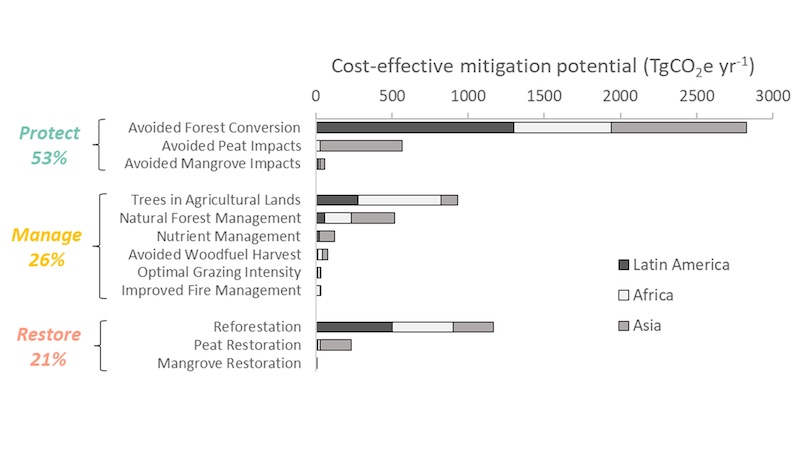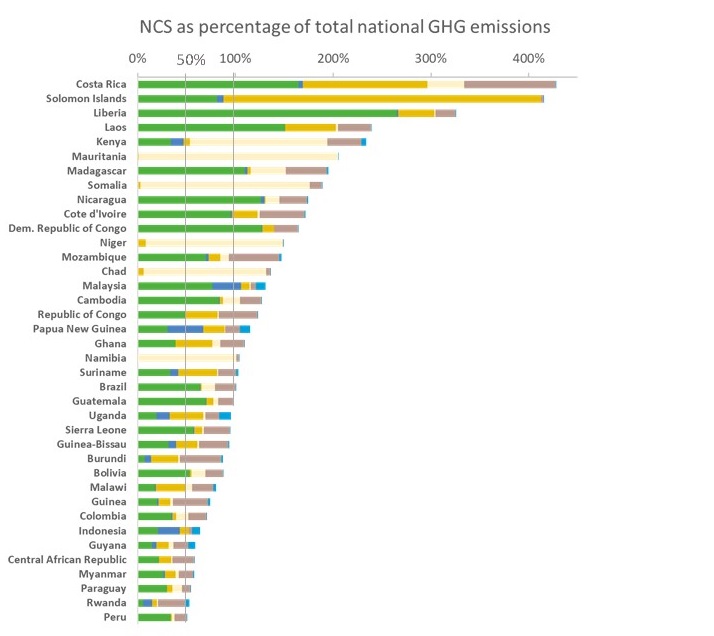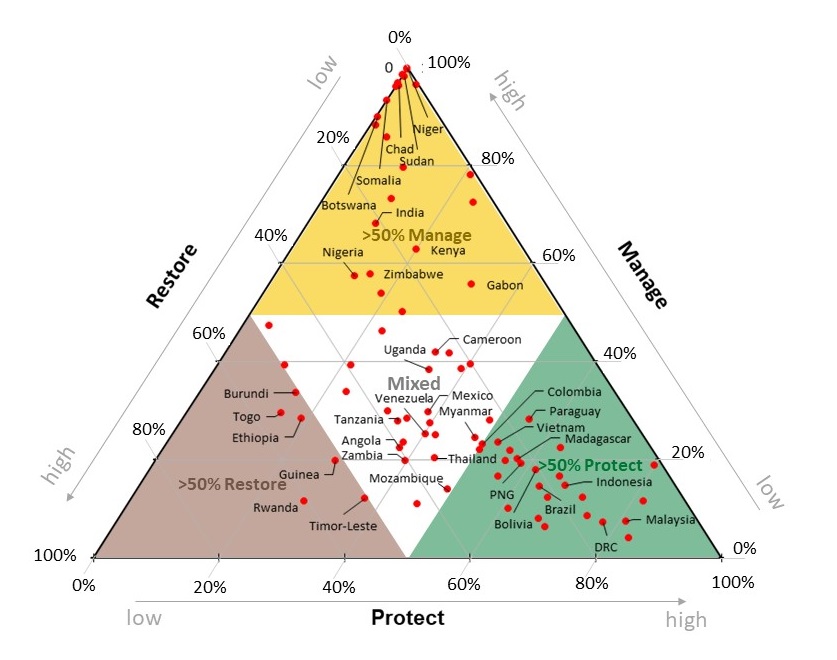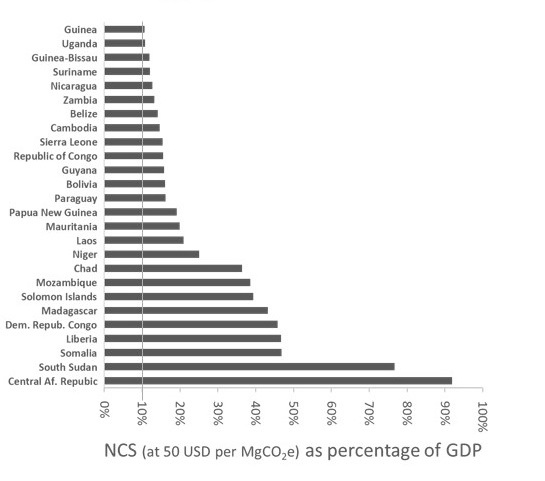In many countries, natural climate solutions can be the biggest climate solutions
Natural climate solutions comprise the largest share of all potential solutions to climate change in more than three dozen tropical countries, according to new research. And in more than 20 of those countries, embracing natural climate solutions—that is, protecting and restoring ecosystems such as forests, mangroves, and grasslands—would be enough for the countries to achieve carbon neutrality before 2030.
These are the findings of a new paper in Philosophical Transactions of the Royal Society B, by Bronson Griscom and twenty other co-authors, including me. The findings might surprise readers in the United States and other temperate countries, where clean energy and low-emissions transportation are the largest options for reducing greenhouse gas emissions, and dominate popular discussions of climate solutions.
A previous paper, published in the Proceedings of the National Academy of Sciences in 2017, found that natural climate solutions offer more than one-third of the overall cost-effective climate solution by 2030 to hold global warming below 2°C. In this new paper, we looked at how much climate mitigation could be provided by natural climate solutions in individual countries.
We found that 12 natural climate solutions across 79 tropical countries could cost-effectively mitigate more greenhouse gas emissions than the entire annual emissions of the United States. A bit less than half the total tropical mitigation potential from natural climate solutions is in Indonesia and Brazil, but there are dozens more countries where natural climate solutions are the biggest potential climate solutions.
While opportunities to mitigate climate change by protecting and restoring ecosystems are sizeable and widespread, many tropical countries will require outside funding to achieve them. Read on for more details.
Twelve natural climate solutions in 79 tropical countries could mitigate more than 6.5 billion tons of CO2 per year. Those numbers are for the year 2030, and only include actions estimated to cost less than $100/tCO2—a level consistent with keeping global warming below 2°C (Figure 1). That’s roughly one-seventh of total global greenhouse gas emissions, and more than the annual emissions of the United States. The biggest opportunities are avoided deforestation (2.8 billion tons CO2 per year), reforestation (1.2 billion tons CO2 per year), adding trees to agricultural lands (0.9 billion tons per year), avoiding degradation of peat soils (0.6 billion tons per year), and improving management of natural forests (0.5 billion tons per year).
That’s only considering the climate benefits of protecting and restoring ecosystems, before even considering the benefits for Indigenous peoples, biodiversity habitat, livelihoods, health, water, and agriculture. The study considers biophysical potential, economic factors, and even governance enabling conditions, though it doesn’t account for countries’ political will.
The region with the greatest potential for natural climate solutions is Asia, with 2.4 billion tons of CO2 per year in 2030, followed closely by Latin America (2.3 billion tons) and Africa (1.9 billion tons).

Indonesia and Brazil offer the greatest potential for natural climate solutions. Together these two countries offer 2.7 billion tons of CO2 per year at a cost of less than $100 per ton by 2030, or 42% of the mitigation potential from natural climate solutions across the 79 countries we studied (Figure 2). In Brazil, nearly two-thirds of that mitigation potential is from avoided deforestation. In Indonesia, one-third of is from avoided deforestation and one-third is from avoided degradation of wetlands (e.g. peatlands and mangroves). The countries with the next-largest potential are Democratic Republic of Congo (5% of the tropical total), India (4%), and Malaysia (4%).

Natural climate solutions are the largest share of climate solutions in many countries. In 38 countries, natural climate solutions are more than 50% of total national GHG emissions. This makes natural climate solutions larger than all other mitigation options combined (Figure 3). In 23 of these countries, natural climate solutions are larger than 100% of total national GHG emissions. That means that by reducing ecosystem-based emissions of carbon to the atmosphere, and increasing ecosystem-based sinks of carbon from the atmosphere, countries such as Costa Rica, the Solomon Islands, Liberia, Laos, and Kenya could become fully carbon neutral, or even net carbon negative, by 2030. In fact, Costa Rica has pledged to become carbon neutral by the end of next year, in part by expanding forest cover.

The largest opportunities for natural climate solutions vary by country. In 25 countries, including some of the biggest (e.g. Indonesia, Brazil, DRC, Malaysia, and Bolivia), the largest opportunity comes from protecting ecosystems (Figure 4). In 23 countries, including India and many countries in Africa, the largest opportunity comes from improving management of ecosystems. And in six countries, mostly in Africa, the largest opportunity comes from restoring ecosystems. 25 other countries are a mix, with no single opportunity predominating.

Many countries will require outside funding to achieve natural climate solutions. There are 26 countries where the amount of natural climate solutions, if valued at $50 per ton, would exceed 10% of GDP (Figure 5). In countries such as Madagascar, Laos, and Nicaragua, natural climate solutions are unlikely to be achieved to their full potential without external support. On the other hand, in such countries, external funding in the form of carbon payments could be a big win-win, providing a substantial new source of funding for green development, and activating these countries’ largest sources of climate mitigation.
Carbon payments can be a win-win even for climate and development even in countries where the potential value of natural climate solutions is much smaller relative to GDP. Many countries have already made conditional climate commitments on deforestation, pledging to reduce emissions by a certain amount on their own, and by a greater amount with the help of external funding (i.e. REDD+). Natural climate solutions amount to one-quarter of the mitigation that countries have pledged—a greater share relative to their emissions than other sectors.

Currently the greatest need for natural climate solutions is funding, including in the form of results-based payments for reducing deforestation (i.e. REDD+). Some important achievements were made in 2019, including the passage of the California Tropical Forest Standard, the introductions of results-based payments at the Green Climate Fund, and new results-based payment agreements with Gabon, Mozambique, and Ghana. But 2019 also saw United Nations negotiators fall short on rules for international carbon trading. Let’s hope 2020 builds on 2019’s successes and remedies its failures, so that natural solutions can fulfill their potential role in preventing climate change.


